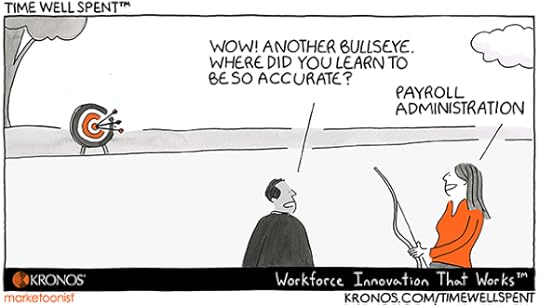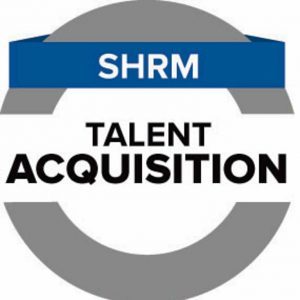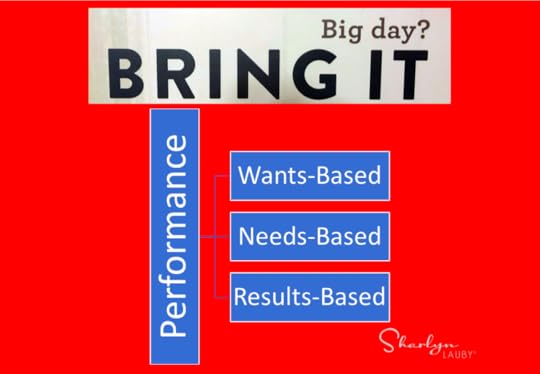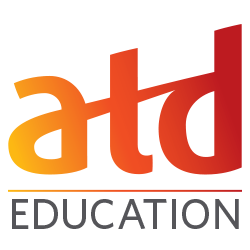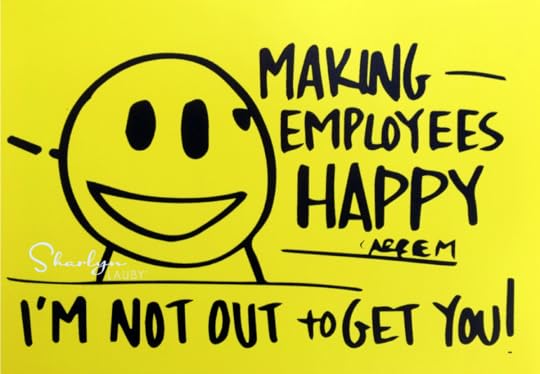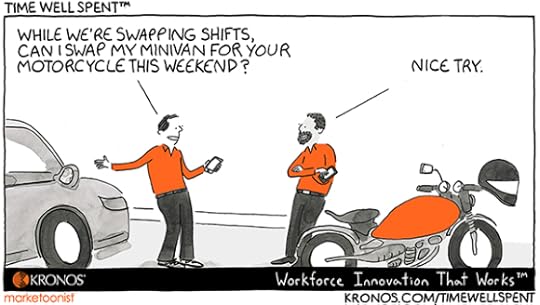Sharlyn J. Lauby's Blog, page 114
July 27, 2018
Find Time to Focus on Accuracy – Friday Distraction
(Editor’s Note: Today’s post is brought to you by our friends at Kronos , a leading provider of workforce management and human capital management cloud solutions. Have you checked out the Kronos blogging community? Lots of great resources focused on being a department of one , workforce management, and competitive differentiation. Enjoy today’s article!)
Years ago, I worked for a company that did everything at the last minute. Even if they didn’t need to. They loved working under the pressure of pulling a project together under a time crunch. It drove me crazy! They could have easily planned the project out, worked on a little bit each day, and completed the project early … without stressing everyone out.
I also wondered if the quality and accuracy of the project suffered as a result. It’s not always the case, but let’s face it, sometimes in an effort to meet a tight deadline we have to cut corners. Obviously, we don’t want to do that. Depending on the project, rushing our work could have an impact on safety and security. As today’s Time Well Spent from our friends at Kronos points out, we need to find ways to focus on the accuracy of our work.
Recognize that all work isn’t eligible for multi-tasking. I realize that we often have to multi-task. That being said, not all work should bemulti-tasked. There are some activities that should be completed on their own. Sometimes that’s because the task is complex. In other cases, it’s because we’re new at the task and need to concentrate. Regardless, we shouldn’t multi-task all day, every day.
Identify tasks that need greater focus and attention. Speaking of multi-tasking, try to think about the tasks you’re responsible for and the best way to complete them. Would it make sense to do them at the beginning or end of the day, when it’s less noisy around the office? Is it possible to do two things at the same time? For example, I do a lot of reading and listening to webinars while walking on my treadmill desk.
Set aside uninterrupted time to complete complex work. If you need to get something done, don’t hesitate to block off an hour on your calendar, close the door, and get it done. It’s better to complete a task in an hour uninterrupted versus two hours with interruptions. Now, I will admit that everything can’t be an uninterrupted task. We do need to be approachable. But when we’re faced with a deadline, sometimes it’s necessary.
I totally get it. Our professional lives are busy and full. On some levels, I wouldn’t have it any other way. But there’s a fine line between busy and overwhelmed. We need to be able to focus and have the time to do our best work. That means knowing when to multi-task and understanding the best ways to disconnect and focus on our work accuracy.
The post Find Time to Focus on Accuracy – Friday Distraction appeared first on hr bartender.






July 26, 2018
7 Business Lessons I Learned Playing Pokemon GO
Yes, I’ll admit it. I enjoy playing Pokemon GO.
For those of you who aren’t familiar with the game. Pokemon GO is an augmented reality game released in 2016. The game involves locating and catching ‘creatures’ (aka Pokemon). Once you catch them, then you use them in battles, etc. The game was awarded the Guinness World Record for most revenue generated by a mobile game and hundreds of millions of people play the game globally.
But, I’m not here to convince you to start playing Pokemon GO. My point with today’s post is to show that games can teach us business lessons. Even if they weren’t designed to. For example, here are seven business lessons I’m reminded of when playing Pokemon GO:
You need to be a good individual contributor and team player. One of the things I like about Pokemon GO is that I can play the game when I’m traveling. But I also enjoy playing with Mr. Bartender. And the game has community days where I can meet new people who also enjoy playing. In our work roles, we have to be prepared to work independently, with small teams, and reach out to co-workers we don’t know very well.
It’s important to learn more than one way of getting stuff done. To catch a Pokemon, you have to hit them with a ball. I think of it as virtual Skee-Ball. But There are three different types of balls. And four different types of treats you can give a Pokemon so they will stay still, so you have a better chance of catching them. You can also catch a Pokemon with a straight throw or a curveball. Just like in business, there are many ways to reach a goal.
Managing resources well is the key to success. Speaking of how to catch a Pokemon, the last thing we want to do is spend a rare Ultra ball when a regular Pokeball will do. Or give a Pokemon a golden raspberry when a banana will suffice. Even if you don’t know what these things are…you get the idea. It’s important to use the right resource at the right time. It’s also important to have plenty of resources on hand.
Learn the strengths and weaknesses of your team. Every Pokemon has powers that you’ll eventually use in battle. It’s important to understand your opponent and choose the right Pokemon for battle. Same happens in business. Any time we’re faced with a challenge, we want to bring the right team. Not only will it help us achieve our goals, but it will help us allocate our resources properly (see #3).
Know when to battle. And who to take with you. I just mentioned battles. In the game, we can visit Pokemon Gyms that are filled with Pokemon. We can assess the situation and decide if we have the resources to battle (and win). If the Pokemon are more powerful, we might not want to spend the resources. In business, we often assess situations and decide if the benefits of battling are worth the expenditure of resources.
Use milestones to tackle big projects. One of the new features in Pokemon are quests. Players are given tasks to complete and after completing a series of tasks, we’re rewarded with a rare Pokemon. It reminds me of the value of breaking large projects into smaller pieces. We can accomplish one thing a day and before we know it, we’ve achieved a big goal. It also helps with keeping individuals motivated.
Make investments so you can achieve your goals. While there are many things you can do for free in the game, there are times when buying some additional resources makes sense. Organizations have to regularly ask themselves, “Would investing in employee training help the business?” or “Should we add headcount?” or “Will a technology upgrade enhance productivity?” Free is nice, but sometimes we need more.
Games can entertain us as well as teach us lessons … if we let them. Think about the games you play. Are there some business lessons you can take away from them? It might be a fun work activity to play a classic board game then debrief with a “What business lessons can we take away from the activity?” Learning can be fun.
Image captured by Sharlyn Lauby somewhere in a mysterious corner of her office.
The post 7 Business Lessons I Learned Playing Pokemon GO appeared first on hr bartender.






July 24, 2018
SHRM Talent Acquisition Specialty Credential: All the Details
(Editor’s Note: There are A LOT of detail in this post about SHRM’s new talent acquisition specialty credential. You might want to consider bookmarking it for future reference.)
A couple of month ago, the Society for Human Resource Management (SHRM) announced a new specialty credential in talent acquisition that is launching this month.
During this year’s SHRM Annual Conference, I learned a few details about the process of earning the credential that you might find interesting. I know it can be tempting to compare the Talent Acquisition Specialty Credential to other certifications like the SHRM-SCP and SHRM-CP, but this isn’t the same and therefore, the process isn’t going to be either.
To earn the credential, individuals must satisfactorily complete the following three activities:
SHRM’s Talent Acquisition: Creating Your Organization’s Strategy seminar (available in-person or online) ;
Six (6) SHRM eLearning courses on talent acquisition-specific topics including recruiting, analytics and hiring trends; and,
An online 50-question knowledge-based assessment.
It’s not a requirement to be SHRM-SCP or SHRM-CP certified to pursue the TA Specialty Credential. However, if you are, the above activities are eligible for Professional Development Credits (PDCs).
So, pursuing this credential can earn you up to 25 PDCs (total). And you would receive those PDCs as you complete each element of the learning plan. The PDCs are automatically uploaded into your certification portal, just like other SHRM seminars and eLearning.
Finally, the PDCs associated with the assessment are received upon completion of the assessment regardless of receiving a passing score. They’re automatically uploaded into the certification portal just like everything else.
Let’s Talk More About the Assessment
Obviously, if you don’t pass the assessment then you won’t receive the Talent Acquisition Specialty Credential, the certificate of achievement, or the digital badge. But that doesn’t have to signal the end of this journey. According to SHRM, individuals will have two attempts to receive a passing score on the assessment. If they’re unsuccessful after two attempts, then they must complete the learning events again and earn a passing score on the assessment. Here are five additional details about the assessment you might like to know.
All 50 questions on the assessment are multiple choice with 4 answer choices. Of the 50 questions, 80 percent are knowledge items and 20 percent are scenario-based items.
Individuals will have 100 minutes to complete the 50-question assessment. The assessment cannot be paused, exited and resumed, or restarted later once it has been started.
The online assessment is computer-based and can be accessed from any computer that has a secure internet connection (i.e. your home or work computer). The assessment is be delivered through the same platform as the 6 eLearning modules.
For security purposes, you will use the same single sign on login information and password that you use when accessing the SHRM website and any eLearning content. This is the unique identifier that will note when the assessment and any of the eLearning modules have been accessed and completed.
Upon completion of the assessment, you will immediately receive a ‘pass’ or ‘not pass’ notification in the SHRM eLearning platform. If a passing score is achieved, you will receive your digital badge within five business days and your certificate will arrive within two weeks.
Why You Should Consider SHRM’s Talent Acquisition Specialty Credential
In my quest to find out as much detail as possible, I chatted with Tony Lee, SHRM’s vice president of editorial, who played the lead role in the introduction of this new credential. I’m thrilled that he graciously agreed to share some insights behind the development of the credential.
Tony, let’s start at the beginning. Why did SHRM decide to offer a Talent Acquisition Specialty Credential?
 [Lee] The talent acquisition field has changed significantly in recent years and recruiters need new skills and strategies to compete for talent. SHRM wants to be at the forefront of addressing these needs. As a result, SHRM is launching the Talent Acquisition Specialty Credential to provide recruiters with the opportunity to gain new skills, distinguish their expertise and build their credibility.
[Lee] The talent acquisition field has changed significantly in recent years and recruiters need new skills and strategies to compete for talent. SHRM wants to be at the forefront of addressing these needs. As a result, SHRM is launching the Talent Acquisition Specialty Credential to provide recruiters with the opportunity to gain new skills, distinguish their expertise and build their credibility.
I assume that when I earn the TA Specialty Credential, I don’t get to add letters to my name. So, how does someone tell the world that they’ve earned it?
[Lee] After passing the assessment, you can add your specialty credential to your resume, e-mail signatures, and social media profiles, proving your talent acquisition expertise to your employer and your network.
We’ve spent quite a bit of time talking about how to earn the credential. But, once I earn the specialty credential, what happens next? Meaning, is there a renewal or recertification process?
[Lee] A SHRM Specialty Credential educates individuals on specific learning objectives. This is done by participating in a series of learning events and passing an assessment to demonstrate comprehension of program learning objectives. You cannot recertify a specialty credential. After three years, you must complete the learning events and pass the assessment to earn a new credential.
You and I both know people with “lifetime” certifications. Can you share with readers the thought process behind making the specialty credential valid for three years?
[Lee] The world of the recruiter is in constant flux. SHRM is committed to reviewing the materials, content, and assessment items annually in order ensure that it is focused on the latest trends, strategies and practices. By taking the credential again after three years, you distinguish yourself as an accomplished talent acquisition professional committed to the continuous improvement of your skills and knowledge.
One last question. Is there a recommended time frame to start/finish earning the specialty credential? And where can someone learn more?
[Lee] After they purchase it, each individual has one full calendar year to complete the three activities of the specialty credential (i.e. the seminar, 6 eLearning modules and the assessment). SHRM realizes each individual has different learning preferences and rates, so it will take some people much less than a year to complete, but they have a full year to accommodate any schedule challenges that may arise.
To learn more, please go to http://l.shrm.org/Seminars/TalentSpecialtyCredential
My thanks to Tony and the SHRM team for sharing all of this detailed information with me. We all know that any time something new is introduced, there are lots of questions. I hope this helps answer some of them. And I hope you’re interested in learning more about the credential by checking out the website.
Talent acquisition professionals play a huge role in the company’s success. They’re responsible for finding and hiring the talent that will help the organization meet its goals. Being able to tell the company and candidates that you’re a skilled, committed recruiter could give you a competitive advantage.
P.S. Tony Lee and I will be conducting a short webcast about the challenges in today’s job market and the essential role that talent acquisition professionals play in helping the organization meet its talent needs. Mark your calendars for Tuesday, August 7, 2018 at 2p Eastern. Registration details will be available soon on the SHRM website. And if you can’t make it…sign up anyway and get the recording.
The post SHRM Talent Acquisition Specialty Credential: All the Details appeared first on hr bartender.






July 22, 2018
High Performing Organizations Focus On a Results Based Approach
This might sound like a strange comment coming from a training consultant, but all performance problems are not solved with training. It’s true. When companies are faced with performance challenges, they need to figure out what the challenge is and address it. The question becomes “What’s the right way to do it?”.
At this year’s Association for Talent Development (ATD) International Conference and Expo, I had the opportunity to participate in a two-day certificate program on Improving Human Performance, which focused on the Human Performance Improvement (HPI) Model. We were also fortunate to have as our facilitator Mason Holloway, vice president at Deltek Universityand the creator of Performance DNA, the most comprehensive and effective tool set for analyzing human performance.
Now, I don’t want to give away the entire program. I already mentioned that the program covers the HPI Model, but there was one takeaway that I do want to share. It has to do with the three approaches organizations take when faced with performance issues.
APPROACH #1: Wants Based Approach
In a wants-based approach, we give stakeholders what they ask for. It might involve asking a few questions to clarify, but basically, we don’t question the “want” (or request).
If we think about this from a training perspective, an example would be when the CEO comes into your office and says, “We need to improve employee engagement. Let’s bring in a motivational speaker to train the team.” Now, we know that motivational speakers bring value, but they probably aren’t the key to unlocking employee engagement. But the “want” is that the CEO asked for it. So that’s the result that happens.
APPROACH #2: Needs Based Approach
There are a couple of ways to look at a needs based approach. First, a solution would be provided based on necessity. An example would be compliance training. This isn’t to say that compliance training isn’t good or important but, in many cases, the initial reason we conduct compliance training is because we “need” to.
The second solution would be a situation where we know there’s an issue and we provide the training or solution to only those who “need” it. A challenge could be whether the solution is the right solution or is it simply a much-needed Band-Aid.
APPROACH #3: Results Based Approach
When we use a results based approach, the request is based on a real business and performance goal. All stakeholders are willing to take the time and use the resources to conduct a full assessment to develop the right solution. Even if it’s not the solution that the organization wants.
Going back to the training example, a results based approach might discover after an analysis that training isn’t the best solution. Maybe it’s an OD intervention.
It won’t be a surprise to anyone that HPI uses a results based approach. That’s where we spent the majority of our time during the program because conducting that level of assessment isn’t easy.
And that’s also where the takeaway was for me. When we’re faced with a problem, we have to think about how we’re going to approach the issue. Not every problem should be handled using HPI. Some problems can be solved using a wants based approach. Others can be solved using a needs based approach. And then there are ones that need the results based approach.
As human resources professionals, it’s part of our job to help the organization understand when to use each approach. For example, we might not want to use a result-based approach when a needs-based approach will do. It doesn’t make good business sense to spend organizational resources in that case.
We also need to make sure that, when a results based approach is necessary, the organization is going to support the effort.
I really enjoyed this program and learned a lot. If you feel your organization could benefit from using a results based approach more often, this might be a program to consider. Check out the ATD Education site for their offerings.
We spend a lot of time talking about recruiting the best talent and setting employees up for success. Part of that is making sure employee performance stays at a high level. But let’s face it, sometimes stuff happens. Organizations need to take steps to bring performance levels back to acceptable levels. The question becomes, “What approach is your organization going to take?”
The post High Performing Organizations Focus On a Results Based Approach appeared first on hr bartender.






July 20, 2018
Bookmark This! 20 Tips for Managers and Leaders
Many of you may know that, a few months ago, Mr. Bartender and I moved from South Florida to the Northern part of the state. As part of the move, we downsized our home and offices. A huge task! But it was so rewarding. It’s amazing how stuff accumulates.
As I was cleaning out my office, I ran across some articles that I had saved with tips and advice for managers. Today, I wouldn’t keep paper articles. I can just save them to Pinterest. But in looking them over, it got me thinking, what are some of those pearls of wisdom that have held up over the course of time? Well, thanks to this pile of decade-old articles, I have a few to share with you.
The first ten are focused on individual traits for managers and leaders. No matter what role you have in the organization, I can see these being important activities to always remember. Not listed in any order of importance (they’re all important!), these would also be equally helpful in our personal lives.
Establish positive work relationships with those around you.
Recognize the contributions of others.
Say “I don’t know” when you don’t.
Carefully manage your time. It’s your scarcest and least renewable resource.
Follow-through in a timely manner.
Have someone you may confide in.
Bring more humor into the workplace.
Continue your personal and professional growth.
Read just for fun.
Smile, it’s contagious.
The next ten I thought were a bit more focused on what we do as managers and leaders in the workplace.
Know your organization’s goals and values, so you can help others achieve them.
Never tolerate discrimination or harassment of any kind.
Don’t always look for one right answer.
Answer questions. Question answers.
Establish a reputation for reliability by completing assignments well and on time.
Learn how to distill large amounts of information into a few salient points.
Learn how to say “no”.
Conduct an honest self-evaluation each year.
Network with people outside of your field.
Recognize that no one is indispensable.
I hope you don’t mind that, on some level, I wrote this post for me. I’m going to bookmark it for myself so that I can occasionally review the tips. Make sure I’m always striving to do these things. I hope you’ll do the same. Together, we can change the world of work.
Image captured by Sharlyn Lauby while exploring the Queen Mary which is docked in Long Beach, CA
The post Bookmark This! 20 Tips for Managers and Leaders appeared first on hr bartender.






July 19, 2018
Can I Get Fired For an Accident – Ask #HR Bartender
Everyone makes mistakes. Everyone. So, can making a mistake get you fired? Well, that’s what this reader note wants to know.
I’m suspended pending investigation. I work in a restaurant on the Vegas strip, I am being accused of breaking a glass on purpose. The glass went into the ice used for customers.
I did not break the glass on purpose, it was wet and slipped out of my hand. If you look at the video, it appears that it was on purpose, but I did not break it on purpose. It was an accident. I have worked in this industry for 15 years, I have NEVER broken anything on purpose. What benefit would I gain doing this?!
I’ve had one meeting with HR. Some of my friends are telling me to just quit and walk away. If I’m fired, I will be unable to work at any of the company’s locations for 2-3 years (and they’re a big employer).
I should add, I work in a hostile environment, the manager does not like me. The feeling is mutual. I know he’s trying to get rid of me.
Thoughts? Fight it because it was an accident or quit?
This story has several complexities to it. I’m not sure we can deal with all the specifics. But there are a few areas where we can look for some insights. To help us understand some of the nuances, I asked our friends at Foley & Lardner LLP if they could assist. And thankfully, they said “yes”. Leonard Feigel is special counsel and a litigation attorney with the firm based in Jacksonville, Florida. He advises employers in all aspects of employment law.
Please remember that Leonard has a regular full-time job as a lawyer and he’s doing this to give back to the profession. His comments should not be construed as legal advice or as pertaining to any specific factual situations. If you have detailed questions, you should address them directly with your friendly neighborhood labor and employment attorney.
Leonard, let’s start our conversation with recording employees on video. Why would an organization want to video record the workplace?
[Feigel] There are various and often multiple different reasons why employers may want to use video surveillance in the workplace. For example, surveillance is often used as a deterrent to theft or other crimes – such as surveillance of a cash register area.
Another reason is to help ensure employee and customer safety, including compliance with safety procedures or policies. It may be common practice in an industry to have surveillance as a crime deterrent and for safety, such as use of video surveillance in convenience stores. To observe employee work performance may also be a reason.
If an organization decides to record employees on video, are there any notifications they need to provide employees?
 [Feigel] Whether employers are required to provide notice to employee before video recording them depends on the law of that particular state. Some states, such as Nevada, have a statute that prohibits video and audio recording of individuals unless one person being on the recording gives his or her consent.
[Feigel] Whether employers are required to provide notice to employee before video recording them depends on the law of that particular state. Some states, such as Nevada, have a statute that prohibits video and audio recording of individuals unless one person being on the recording gives his or her consent.
With the situation described above where there is surveillance of an area likely covering employees and customers, employers generally provide notice either to its employees (so it has the consent of its employees being recorded) or through a displayed sign to everyone in the area. The sign usually will state something along the lines of “This store or restaurant uses video surveillance and by entering you consent to the surveillance.”
Other states have statutes requiring the consent of all individuals being recorded, which would require notice – which again is usually provided through a sign.
Where the surveillance is located can also play a role. Some states such as New York and West Virginia require employers give notice and employees to consent if there is surveillance in locker rooms, restrooms or changing area. Other states have general invasion of privacy laws that protect employees from surveillance in areas where a reasonable person would think is private, such as a bathroom or possibly a private office. If an employer wanted to conduct surveillance in a private area it would likely give notice that the area is subject to surveillance or inspection and the employee does not have a reasonable expectation of privacy in that area. Surveillance of a public area in a restaurant generally would not qualify as private, so the employer would not need to provide notice, especially if the video camera is conspicuous.
What are the possible pros/cons to using a video to make determinations about employee performance?
[Feigel] The most obvious pro is that there is a concrete visual recording of what actually happened and when it happened, which is more reliable than witnesses that may have faulty memories. Further, it is unbiased evidence, so there is not a risk that a witness is providing untrue or biased testimony because he/she does not like the alleged wrongdoer.
A possible con is that the video may not provide the best angle or visual viewpoint of what really happened, and the employer may give the video improper weight in determining what happened rather than relying on other reliable evidence. Also, many surveillance systems are video only (no audio) so video may not provide the whole story.
The reader note is pointing out accidental versus intentional behavior. If an employee does harm (or potentially does harm), but it was accidental, does that make a difference? Why or why not?
[Feigel] Whether an employee’s misconduct or behavior was intentional or accidental typically makes a difference. As a general matter, employers are not out to fire good employees that were the victim of an accident. Replacing employees cost employers money, and it is more profitable to have a stable workforce of good employees than to constantly be replacing employees.
However, just because an employee claims it was an accident may not save an employee’s job if the accident arose because the employee violated a policy (such as a safety policy) or from an egregious error in judgment. For example, if forklift employees are trained never to transport more than 1 box at a time, but a forklift driver attempts to transport 5 boxes that results in an accident that injures another employee, termination could be appropriate even though the forklift driver did not intend for the boxes to fall off the forklift. In sum, circumstances matter.
The reader note also mentions hostile environment. We don’t know any specifics except that they’ve met with HR. As a general rule, should HR factor manager – employee relationships into their investigations? Why or why not?
[Feigel] To a degree, yes. HR’s investigation ideally should aim on trying to determine the facts, and thereafter the fair and appropriate treatment of the employee (which may include disciplinary action). If a manager and employee have a toxic relationship, the manager may be biased against the employee. Accordingly, the bias may intentionally or unintentionally affect the manager’s memory of an incident or even motivate the manager to provide untruthful testimony. Accordingly, HR may choose to give more weight to other witness statements.
Last question. How should the employee weigh the quit versus get fired decision?
[Feigel] The critical issue, as I see it, is how important is it that the employee be eligible to work at the employer’s other restaurants. The employee is clear that he/she would not be eligible to work at the other restaurants if he/she was fired, but I would have concerns that by simply quitting, especially while on suspension pending the conclusion of an investigation, he/she could preserve his/her eligibility to work at the employer’s other restaurants. Otherwise, employees would always quit before being fired.
Also, the same HR personnel would likely be involved with the hiring decision at the other restaurant. In sum, the results of HR’s investigation, whether final or preliminary, are likely important for the employee’s prospects for future employment with the employer’s other restaurants.
I want to extend a HUGE thanks to Leonard for sharing his experience with us. If you’re looking to stay on top of labor and employment law issues, be sure to sign up for Foley & Lardner’s electronic newsletter or follow one of their blogs. They are on my must-read list.
Leonard’s comment about employers not wanting to fire good employees really resonated with me. That includes employees who make mistakes or have an accident. Organizations would be well served to learn how to deal with employee mistakes of all sizes.
P.S. Today’s image (captured by Sharlyn Lauby at the 2106 HR Tech Conference) reminded me that it’s time to start thinking about the 2018 HR Technology Conference & Expo. The event will be held September 11-14, 2018 in Las Vegas. Keynote speakers include Mike Rowe and Randi Zuckerberg. Act quickly because the Early Bird rate will be ending soon!
The post Can I Get Fired For an Accident – Ask #HR Bartender appeared first on hr bartender.






July 17, 2018
Improve Quality of Hire Using Recruiting Data and Analytics
(Editor’s Note: Today’s post is brought to you by our friends at Criteria Corp, a leading provider of pre-employment testing services. They’ve just relaunched their customer interface, HireSelect. It’s been completely reworked to help organizations hire faster and smarter. Enjoy the post!)
Regular readers of this blog know I’ve talked on numerous occasions about the need to use technology strategically in the business. Technology can bring compliance, consistency, and scalability. It can reduce administration, so organizations can spend more time with candidates and employees.
Technology can also aid in data collection and analysis. Now to make sure we’re all on the same page here, let’s look at a couple of definitions. Data are facts and statistics collected for reference or analysis. And analytics is the systemic analysis of data or statistics. I know that at times I’m guilty of using terms like data and analytics interchangeably. But for today’s conversation, it’s important to note that data is the information and analytics is what you do with it.
The reason I’m bringing this up is because recruiting technologies, data, and analytics aren’t anything for organizations to be hesitant about. Let’s take artificial intelligence (AI) for example. Organizations were initially resistant (understandably), but they’re gradually becoming used to it. That’s because they’ve realized how AI isn’t replacing business functions; it’s actually making processes easier AND helping managers make more informed decisions.
In the above example, using AI shouldn’t be viewed as an “all or nothing” proposition. It just means that the organization has extra resources to help them achieve their goals.
Now let’s shift to recruiting data. The same principles apply. Organizations might be reluctant to use data and analytics in recruiting. The good news is there are many different types of recruiting data. Here are a few examples:
· Sourcing data includes effectiveness by source and hires by source.
· Planning data includes census data, headcount, and employee tenure.
· Recruiting data includes vacancy rates and new hire retention.
Another form of recruiting data to consider is pre-employment assessments, such as cognitive or behavioral assessments. Yes, that’s right. We should think of pre-employment assessments as a form of data. This might be a new way of thinking for some organizations. But, consider this – for any candidate that a company is evaluating, their test scores can be viewed as an additional data point to help the recruiting team make a more informed hiring decision.
Using Recruiting Data Responsibly
I must admit that I really like this line of thinking about pre-employment testing because it aligns with the basic rules and guidelines we need to follow when dealing with data.
Establish the goal. Recruiting data should align with your recruiting strategy. When we’re talking about pre-employment testing, that means knowing why the organization is conducting testing.
Agree on the data. Organizations need to research the best pre-employment assessments to make sure they are using a test that is valid and reliable. They should research and purchase assessments from a reputable vendor.
Support the process. Testing isn’t meant to make the hiring decision for you, it’s meant to provide you with more information so that you have a richer understanding of a candidate’s potential.
Guide selection. While pre-employment testing is scientifically proven to be more predictive of job performance than most other traditional hiring factors, that doesn’t mean it should be the sole deciding factor, since those other factors (i.e. interviews, experience, etc.) are still very relevant and valuable.
Train stakeholders. Anyone responsible for using data needs to understand how the data is collected and how to properly interpret it. Same goes with pre-employment testing.
I asked Criteria Corp CEO Josh Millet to share his philosophy about the relationship between testing, data, and analytics. “Our philosophy is that data (i.e. pre-employment tests) provides very little value if it isn’t properly validated to be predictive of job success. If you’re relying on a metric that isn’t validated and isn’t predictive of anything, you’re ultimately just wasting your time and potentially even making a misguided decision. This is why it’s so important to use a testing vendor that offers tests that are scientifically validated in the context of employment outcomes.”
Use Pre-Employment Testing as a Data Point
Treating pre-employment testing as a data point in the recruiting process gives organizations a different perspective on how to use testing. Not as a silver bullet to solve all your recruiting challenges, but as a complement to the other steps in the hiring process. Because when we give data and analytics the right place in the hiring process, we’ll get good outcomes. In this case, that means good hires for the company.
If you want to learn more about how pre-employment testing can benefit your recruiting strategy, check out Criteria Corp’s “Definitive Guide to Pre-Employment Testing”. I found this to be a comprehensive guide that I’ve got on the corner of my desk all the time.
The post Improve Quality of Hire Using Recruiting Data and Analytics appeared first on hr bartender.






July 15, 2018
Technology Plays a Part In the Employee Experience
I’ve heard the comment many times that technology is just a tool. By definition, a tool is a device used to carry out a particular function. That totally makes sense. We use our tech to communicate, make purchases, learn new things, etc. So, technology is a tool.
But I also can’t help but wonder if it’s more than that because not having technology can be a disadvantage. For example, I was chatting with some talent acquisition professionals recently and we got on the topic of recruiting technology. One person at the table said that her company didn’t have an applicant tracking system (ATS). She felt that not having this piece of tech was really holding back their effort to attract the best talent.
Does that mean there could be a point where a tool is so important that it becomes more than a tool? And is technology in that place? It might be time for organizations to start asking some questions:
Does not having recruiting technology mean we face a disadvantage when it comes to hiring the best talent?
Is not having a performance management system mean we’re incapable of being high-performance?
How does not having a learning management system impact our ability to develop their future workforce?
You get my point. People have too many excellent tech experiences in their personal lives that they expect technology in their professional lives. Organizations can’t afford not to invest in their technology. It’s a necessary component of the candidate and employee experience.
As someone who remembers working with a typewriter, I can’t imagine doing it today. I mean seriously, could you imagine working for a company without word processing software?! And as more technologies become an essential part of our lives, it will only create more pressure on businesses to add tech. On a personal note, I will freely admit that it took us a long time to get rid of our landline and now that a few months have passed, I wonder what took me so long.
That being said, tech isn’t always cheap – even when it provides a return on investment. Organizations should be thinking now about their technology adoption strategy. Start getting the budget in place and getting employees ready for the transition. Adding technology isn’t about reducing headcount. It’s about building an employee experience that aligns with capabilities that employees can experience outside of work.
Image captured by Sharlyn Lauby while exploring the streets of Fort Lauderdale, FL
The post Technology Plays a Part In the Employee Experience appeared first on hr bartender.






July 13, 2018
Employees Should Establish Their Own Priorities
A couple of months ago, I wrote an article about Kronos’ transition from a traditional time-off policy to an unlimited time-off program (called myTime). On some level, I like to think of the concept of unlimited time off as Paid Time Off 2.0. Decades ago, organizations had vacation, paid sick time, and holidays. Then they decided to merge all these categories together and give employees one balance called Paid Time Off (PTO).
Today, an increasing number of employers are simply saying, “You know your job and what you need to do. Take off when you need to.” IMHO, it sounds very refreshing for employees. They can take off to spend the time with family. Or as this Time Well Spent from our friends at Kronos points out, they can take a couple of days off for some “me” time. Whatever the reason or priorities, the employee gets to decide what’s important to them.
That isn’t to say unlimited time off doesn’t come with some challenges. Chief People Officer David Almeda mentions in a case study on The Workforce Institute blog that managers received training, so they could manage the new program and also rethink their role when it came to employee scheduling. It makes total sense. In a traditional time-off environment, managers had to schedule, monitor, and administer time off. Now, with unlimited time off, they’re more of a facilitator and I’m sure it takes some getting used to.
But it also means that employees have to rethink their requests. In the past, they could ask for time off, and the manager decided whether or not it was approved. Now, employees need to understand what their priorities are. Just because you can take off doesn’t mean you should. As a consultant, this is a lesson I learned very early. For example, when it comes to tasks, there are some things I do during the normal weekday – like grocery shopping – because I can, and it takes a lot less time. But there are things I do on the weekends, like the laundry.
When employees are given the ability to request time off, they have to figure out how to balance their requests with company priorities. Employees still have to get their work done. Kronos has been very open about their program results and that employee requests are not significantly greater under the unlimited time off program. But for companies considering a move to this type of program, it might be worth offering employees some type of training as well, similar to the training that managers received.
Employees want to have the freedom to make their own decisions. But when they’ve never had that ability before, it could take some adjustments.
The post Employees Should Establish Their Own Priorities appeared first on hr bartender.






July 12, 2018
Leadership or Culture: Which Comes First
There’s a common saying out there that “culture eats strategy” for breakfast (or lunch). The idea being that company culture drives the way strategies are created. Totally makes sense.
What I struggle with is where leadership fits into this conversation. On one hand, the company’s leadership helps shape organizational culture. On the other hand, culture supports and develops leaders.
If leadership comes first, and leaders create the culture, is it okay when new leaders arrive and change the culture? For example, when Tim Cook became CEO of Apple after Steve Jobs passed away, the culture changed. I’m not here to argue whether the Apple culture was or is good, the point is…the culture changed.
Conversely, company cultures drive things like talent strategy. I’ve worked for organizations where developing and promoting employees from within was a top priority. And I’ve worked in other places, where hiring the best talent from outside was more important. So, culture has a direct impact on where leaders come from and how they connect to the company.
I don’t know that I have answers on this one. But I would love to hear what you think. Tell us in this completely unscientific one-question poll: what comes first – leadership or culture?
Sharlyn J. Lauby's Blog
- Sharlyn J. Lauby's profile
- 10 followers


